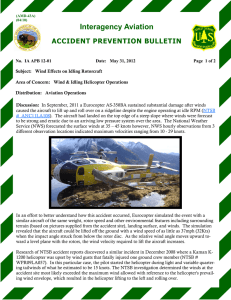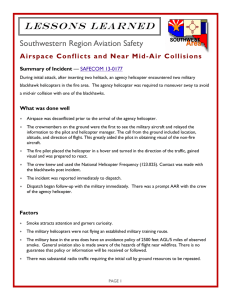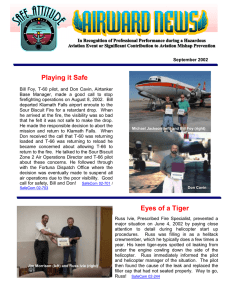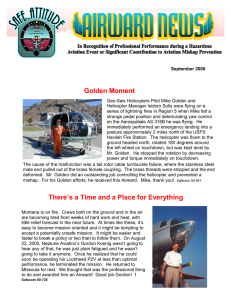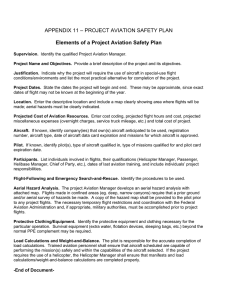Oil in Antarctica?
advertisement
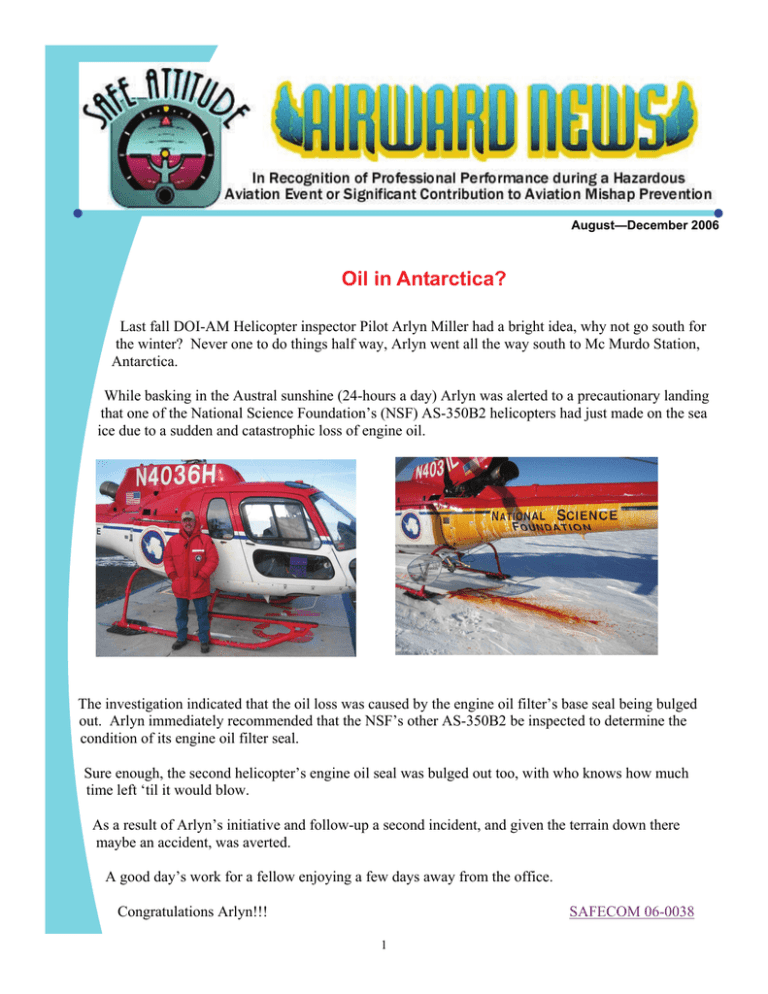
August—December 2006 Oil in Antarctica? Last fall DOI-AM Helicopter inspector Pilot Arlyn Miller had a bright idea, why not go south for the winter? Never one to do things half way, Arlyn went all the way south to Mc Murdo Station, Antarctica. While basking in the Austral sunshine (24-hours a day) Arlyn was alerted to a precautionary landing that one of the National Science Foundation’s (NSF) AS-350B2 helicopters had just made on the sea ice due to a sudden and catastrophic loss of engine oil. The investigation indicated that the oil loss was caused by the engine oil filter’s base seal being bulged out. Arlyn immediately recommended that the NSF’s other AS-350B2 be inspected to determine the condition of its engine oil filter seal. Sure enough, the second helicopter’s engine oil seal was bulged out too, with who knows how much time left ‘til it would blow. As a result of Arlyn’s initiative and follow-up a second incident, and given the terrain down there maybe an accident, was averted. A good day’s work for a fellow enjoying a few days away from the office. Congratulations Arlyn!!! SAFECOM 06-0038 1 That’s Hot!!! On May 21, 2006 while on assignment as an ATGS (Air Tactical Group Supervisor) in the Southwest Area, Bob Bahr identified a takeoff limitation with the assigned Aero Commander (AC-500) due to the lack of performance data beyond 40 degrees C. (104 degrees F.). Although Bob has approximately 1000 hours in the AC-500 aircraft he had never worked with them at the high temperatures seen in parts of the southwest. The first day of his assignment he asked Randy Lynch, air attack pilot for Spur Aviation’s AC-500S (N535SA) what limitations they may have due to high temperatures. The AC-500’s performance charts were consulted and it was found that they stopped at 40 C/104 F. Bob then contacted the COR for the aircraft (Allen Edmonds, Montana State Aviation Manager) and notified him of the findings. He also discussed these findings with Al Alverez, the acting Arizona State Aviation Manager. Bob and Al both agreed that 104 F had to be used as a takeoff limitation. Al then briefed the Arizona State FMO on the issue. Bob Bahr and pilot Randy Lynch discussed ways to limit this restriction on their missions. They agreed to monitor the forecasted and actual temperatures and planned alternative airports to relocate to during the heat of the day. They also agreed to base the “go/no go decision” on temperatures as a crew, with either party able to refuse flight. On June 2, 2006 TECH BULLETIN number 06-01 was issued on the temperature issue. After discovering this issue, Randy Lynch, notified the owner of Spur Aviation, Mike Walker. Mr. Walker started action to update the performance charts at his expense. There is now an approved performance chart up to 125 F. Great Job, Thanks No SAFECOM submitted Helicopter Manager makes a GREAT Catch On July 21, a Sikorsky S61, was released from the Jackass Fire and reassigned to the Trailhead Fire on the Sawtooth N.F. A load calculation was completed and the helicopter commenced with bucket operations with a 660 gallon Bambi bucket. Upon closer inspection of the load calculation form the manager, Greg Wilsopn noticed that the actual payload was in excess of the allowable payload. Greg requested that the bucket be cinched down to the minimum of 70 and the fuel load reduced to help mitigate the problem. The fuel load was reduced, but the actual fuel was not accurately reflected on the load calculation. It became apparent that even with the bucket at 70% and a reduction in fuel, the actual payload would still be greater than the allowable. Greg then consulted with the helibase manager and notified the Contracting Officer. The Contracting Officer stated that the helicopter contract had been suspended and removed from the resource list and should not have been dispatched. The helicopter was released and returned to its home base. There was an obvious communication breakdown between contracting and dispatch as to the availability status of the aircraft. Greg did an outstanding job in reviewing the load calculation form and following up on the discrepancy. Great catch Greg and thanks for being vigilant. Greg Wilson and Jim Morrison 2 Helicopter managers need to be vigilant in reviewing load calculations and make some calls when things don’t add up. SAFECOM 06-0847 A Team Approach to Risk Management Good teamwork, a healthy respect for high winds and turbulence, and a safety-conscious attitude regarding mission accomplishment distinguishes five aviators as professionals that we can all be proud of. On June 14, 2006 a high wind event was predicted for eastern Utah and western Colorado with winds expected to exceed 40 miles per hour. Given the mountainous terrain, serious turbulence was inevitable. At Grand Junction the crews of P2V-7 (Tanker 43 with PIC Bob West and Co-pilot Skip Anderson), Air Tractor – 802 (Tanker 450 with pilot Doug Hodges), and Leadplane Bravo 5 (a King Air with Air Tactical Pilot (ATP) Mike Lynn and Air Tactical Supervisor (ATS) Ken Perry) saw the forecast early in the morning and decided that before heavily loaded air tankers would venture out that it would be much less risky to allow the leadplane to fly out and evaluate the actual conditions (good risk management by limiting exposure to only the aircraft best equipped to handle the hazardous environment) After some tossing and turning (and maybe a little stomach churning) Mike and Ken arrived at the fire and determined that because of the extremely high winds and the effects of the terrain that safe tanker operations were out of the question for a while. Over the next several hours several requests for tanker support were received and Lead Bravo 5 took off and made a second weather check, but until the winds died down the missions were turned down. This is always a tough call, but in this case it was the right call. Finally, late in the afternoon the winds and turbulence abated to the point that the risk of tanker operations (at least in east central Utah) became acceptable. In the words of the unit aviation officer “The aircrews demonstrated a professional attitude and desire to do the right thing while not putting themselves and firefighters on the ground at additional risk.” We couldn’t agree more. Our hats are off to the teamwork, risk management, and professional approach that Mike, Ken, Bob, Skip, and Doug displayed in getting the job done… SAFELY. SAFECOM 06-381 Keepin’ your cool in Antarctica Chris Dean was flying 3 passengers in an AS-350B2 from the helibase at McMurdo across the sea ice to a field camp 45 miles away when he noticed his engine oil pressure suddenly start to decrease. Chris, ever the cool character, immediately began to return to McMurdo. But, before he could do anything the engine oil pressure warning light illuminated. Chris abandoned the idea of returning to McMurdo and announced in a clear and calm voice that he was making a precautionary landing to the sea ice and that he’d appreciate the assistance of a mechanic. Even though Chris reacted immediately and entered a power-on autorotation nearly all of the engine oil was lost before he could land the aircraft. Chris’s quick and decisive action clearly prevented major damage to the engine, which prevented a total engine failure and possible damage to the aircraft and injury to himself and his passengers. SAFECOM 06-0038 3 The Best Choice; A Night on a Frozen Arctic Lagoon Days are short and cold in the Alaskan Arctic. When National Park Service pilot Galen Howell and his observer took off last February in their Aviat Husky for a radio tracking mission, the weather was good VFR and forecast to remain that way. Their plan was to be safely back in Kotzebue in two hours, well before the early winter sunset, but Mother Nature had other ideas. Galen Howell receiving award from Richard On his return to Kotzebue the Flight Service Station informed Galen that a sudden storm had come in off the Bering Sea and that visibility was down to one and one half miles in blowing snow, with winds 20 knots gusting to 28 and increasing. Galen wisely elected to land the VFR-only skiplane on a frozen lagoon nine miles east of the airport and await better weather. Unfortunately, conditions continued to deteriorate. With darkness coming on and the wind chill plunging, the crew pitched a tent in the lee of a snowdrift and spent the sub-zero night in their survival gear. The ground blizzard abated by morning and with equipment snow machined out from town, the airplane was pre-heated, and safely flown into Kotzebue in beautiful VFR weather. Galen’s aeronautical decision-making under difficult circumstances resulted in a chilly night but a safe flight. The lesson we can all take home is never to place convenience and comfort above safety. Good job Galen for making a smart call! SAFECOM 06-0132 Hehr A Hero On the June 10, 2006, Deron Hehr, a Bell-212 pilot for Temsco Helicopters of Alaska demonstrated his superior flying skills while working on the Parks Highway Fire just outside of Nenana, Alaska. A fire crew had set up a pump and hoselay for structure protection of a primary residence and moved on to other structures in the area. The fire heated up and made several runs, pushed by strong winds. The crew tried to return to start the pump as the main front was headed their way but before they could reach the pump the fire made a strong run at them and the crew was forced back due to the intensity of the fire. A strike team leader with the crew called Deron on the radio and told him of their situation. With only seconds to spare, Deron made a precision bucket drop that knocked down the fire that was headed for the pump allowing the firefighters to get back to the pump and save the house from certain destruction. According to the folks at the Alaska Fire Service who work with Deron this is just one of many instances where Deron has demonstrated his aerial skills and selfless devotion to duty. Thanks Deron for another job well done. No SAFECOM submitted 4 A.U.T. for You and Me The employees of the Tongass National Forest live on shaggy Spruce-covered islands surrounded by wilderness areas and the jade-green waters of the Inside Passage. How do they get to the woods? They fly. They fly a lot. In 2005 they flew; 3,562 hours in small float-equipped aircraft, mostly Beavers and Cessna 185’s. Contract MD500 helicopters flew them for 920.2 hours. Southeast Alaska is known for hypothermic waters, heavy rain, constant fog and unforgiving weather. Safety is vital for survival here and safety starts with training; Aviation User Training (AUT). Training presented by the dedicated aviation officers, dispatchers, and helicopter managers of the Tongass. Aviation User Training is Region-10’s take on “IAT: A-110” the national recognized standard for basic aviation training. The Tongass Aviation Group gives this multi-media presentation all across Southeast Alaska, from Yakutat Ranger District neighboring Glacier Bay National Park to Ketchikan Ranger District neighboring the Dixon Entrance. The group gives a couple dozen public presentations within a 4 month period annually not to mention countless one-on-one sessions to over 200 students, including forest employees, regional office employees, Forest Science Lab employees and cooperators. Each presentation is fine tuned to the audience’s needs and in addition to the formal PowerPoint presentation, might include: • radio usage, • training films, • a clip from a Hollywood film to test the audience’s knowledge of the safety skills they’ve learned, • a "walkaround" presentation with an actual helicopter or fixed wing, • and possibly even getting tossed into the local swimming pool during Underwater Egress Familiarization. District Ranger Patty Grantham from Petersburg, Alaska considers this training “a critical piece of our overall safety program.” She might be proved correct by the fact that in 2006 the Tongass NF celebrated 10 years of accident free flying. Jeff Schlee giving walk- around during training 5 Trina Ives, Alicia Sterans, Vivian Hjort and Bill Moulton from Petersburg Patti huddleston, Libby Dougan and Mike Stracey from Sitka. Not pictured are John Krossee, Yvonne Blankenship and Don Andreasen from Ketchican. Unsettling With Power According to Helicopter Manager Craig Hall, Summit Helicopter’s pilot Ron Jackson is one of the most skilled and professional pilots he’s ever worked with. From his actions on the morning of June 12, 2006, we’d have to agree. Ron started the day in his Bell 205A-1++ doing bucket work using a 120 foot long line from a dipsite at the 7,500 foot level in support of the Harper’s East fire in northeast Colorado. The winds had been light from the southeast all day so on Ron’s fourth trip he set up his approach to the dipsite just as he had on the first three trips. Just as the bucket was hitting the water things got real bad, real fast when the winds shifted to his right rear and increased causing the aircraft to settle. Ron recognized the onset of settling with power and quickly reduced power and applied forward cyclic to fly out of the situation. During all this excitement Ron tried to electrically and then manually release the bucket and the long line, but at this moment the helicopter was beginning to spin to the right and it seemed like an eternity before the load jettisoned. All this happened in an instant because by the time he was at 30 feet Ron had the aircraft back under control and headed back to the helibase. Post-incident inspection by the mechanic determined that Ron’s calm, but quick, reaction not only saved the aircraft (and himself), and he hadn’t even exceeded any limitations. Great job Ron, thanks for a job well done! SAFECOM 06-0363 Aviation Safety Offices http://www.fs.fed.us/fire/av_safety/ - http://amd.nbc.gov/safety/ 6
